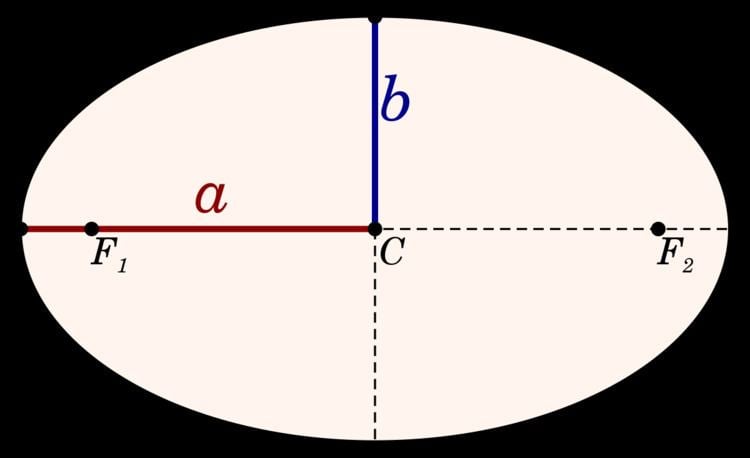 | ||
In geometry, the major axis of an ellipse is its longest diameter: a line segment that runs through the center and both foci, with ends at the widest points of the perimeter. The semi-major axis is one half of the major axis, and thus runs from the centre, through a focus, and to the perimeter. Essentially, it is the radius of an orbit at the orbit's two most distant points. For the special case of a circle, the semi-major axis is the radius. One can think of the semi-major axis as an ellipse's long radius.
Contents
- Ellipse
- Hyperbola
- Orbital period
- Average distance
- Energy calculation of semi major axis from state vectors
- References
The length of the semi-major axis
The semi-major axis of a hyperbola is, depending on the convention, plus or minus one half of the distance between the two branches. Thus it is the distance from the center to either vertex (turning point) of the hyperbola.
A parabola can be obtained as the limit of a sequence of ellipses where one focus is kept fixed as the other is allowed to move arbitrarily far away in one direction, keeping
The semi-minor axis (also semiminor axis) is a line segment associated with most conic sections (that is, with ellipses and hyperbolas) that is at right angles with the semi-major axis and has one end at the center of the conic section. It is one of the axes of symmetry for the curve: in an ellipse, the shorter one; in a hyperbola, the one that does not intersect the hyperbola.
Ellipse
The semi-major axis is the mean value of the maximum and minimum distances
The semi-minor axis of an ellipse is the geometric mean of these distances:
The eccentricity of an ellipse is defined as
Now consider the equation in polar coordinates, with one focus at the origin and the other on the negative x-axis,
The mean value of
In an ellipse, the semi-major axis is the geometric mean of the distance from the center to either focus and the distance from the center to either directrix.
The semi-minor axis of an ellipse runs from the center of the ellipse (a point halfway between and on the line running between the foci) to the edge of the ellipse. The semi-minor axis is half of the minor axis. The minor axis is the longest line segment perpendicular to the major axis that connects two points on the ellipse's edge.
The semi-minor axis
A parabola can be obtained as the limit of a sequence of ellipses where one focus is kept fixed as the other is allowed to move arbitrarily far away in one direction, keeping
The length of the semi-minor axis could also be found using the following formula,
where
Hyperbola
The semi-major axis of a hyperbola is, depending on the convention, plus or minus one half of the distance between the two branches; if this is
In terms of the semi-latus rectum and the eccentricity we have
The transverse axis of a hyperbola coincides with the semi-major axis.
In a hyperbola, a conjugate axis or minor axis of length
The semi-minor axis is also the distance from one of focuses of the hyperbola to an asymptote. Often called the impact parameter, this is important in physics and astronomy, and measure the distance a particle will miss the focus by if its journey is unperturbed by the body at the focus.
The semi-minor axis and the semi-major axis are related through the eccentricity, as follows:
Note that in a hyperbola
Orbital period
In astrodynamics the orbital period
where:
Note that for all ellipses with a given semi-major axis, the orbital period is the same, regardless of eccentricity.
The specific angular momentum
where:
In astronomy, the semi-major axis is one of the most important orbital elements of an orbit, along with its orbital period. For Solar System objects, the semi-major axis is related to the period of the orbit by Kepler's third law (originally empirically derived),
where
where
The orbiting body's path around the barycentre and its path relative to its primary are both ellipses. The semi-major axis is sometimes used in astronomy as the primary-to-secondary distance when the mass ratio of the primary to the secondary is significantly large (
Average distance
It is often said that the semi-major axis is the "average" distance between the primary focus of the ellipse and the orbiting body. This is not quite accurate, because it depends on what the average is taken over.
The time-averaged value of the reciprocal of the radius,
Energy; calculation of semi-major axis from state vectors
In astrodynamics, the semi-major axis
for an elliptical orbit and, depending on the convention, the same or
for a hyperbolic trajectory
and
and
(standard gravitational parameter), where:
Note that for a given amount of total mass, the specific energy and the semi-major axis are always the same, regardless of eccentricity or the ratio of the masses. Conversely, for a given total mass and semi-major axis, the total specific orbital energy is always the same. This statement will always be true under any given conditions.
